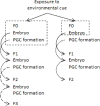Epigenomics of hypertension
- PMID: 24011581
- PMCID: PMC3777799
- DOI: 10.1016/j.semnephrol.2013.05.011
Epigenomics of hypertension
Abstract
Multiple genes and pathways are involved in the pathogenesis of hypertension. Epigenomic studies of hypertension are beginning to emerge and hold great promise of providing novel insights into the mechanisms underlying hypertension. Epigenetic marks or mediators including DNA methylation, histone modifications, and noncoding RNA can be studied at a genome or near-genome scale using epigenomic approaches. At the single gene level, several studies have identified changes in epigenetic modifications in genes expressed in the kidney that correlate with the development of hypertension. Systematic analysis and integration of epigenetic marks at the genome-wide scale, demonstration of cellular and physiological roles of specific epigenetic modifications, and investigation of inheritance are among the major challenges and opportunities for future epigenomic and epigenetic studies of hypertension.
Keywords: DNA methylation; Epigenetics; blood pressure; histone modification; kidney.
© 2013 Elsevier Inc. All rights reserved.
Conflict of interest statement
Financial disclosure and conflict of interest statement: None.
Figures



References
Publication types
MeSH terms
Grants and funding
LinkOut - more resources
Full Text Sources
Other Literature Sources
Medical

